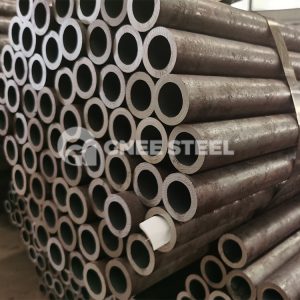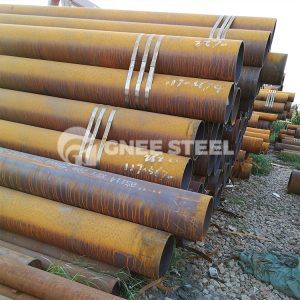The heat treatment process of seamless steel pipe mainly includes the following five categories:
1. Quenching + high temperature tempering
The steel pipe is heated to the quenching temperature so that the internal structure of the steel pipe is transformed into austenite, and then cooled rapidly at a certain speed. Greater than the critical quenching speed will transform the internal structure of the steel pipe into martensite, and then through high-temperature tempering, the steel pipe structure is ultimately transformed into a uniformly tempered Soxhlet organisation. This process not only improves the strength and hardness of the steel pipe, but also organically combines the strength, plasticity and toughness of the steel pipe.

2.Normalising
After heating the steel pipe to the normalising temperature, the internal structure of the steel pipe is completely transformed into austenitic organisation, followed by the heat treatment process of cooling with air as the medium. Different metal structures can be obtained after normalising, such as pearlite, bainite, martensite or a mixture of them. This process not only refines the grain, homogenises the composition and removes stress, but also increases the hardness of the tube and improves its cutting properties.

3. Normalising + Tempering
After heating the steel pipe to the normalising temperature, the internal structure of the pipe is completely transformed into an austenitic structure, which is then cooled in air and then matched with the tempering process. The steel pipe structure is tempered ferrite + pearlite, or ferrite + bainite, or tempered bainite, or tempered martensite, or tempered volcanic pearlitic. This process stabilises the internal structure of the tube and improves the plasticity and toughness of the tube.
4. Annealing
After the tube is heated to the annealing temperature and held for a certain period of time, it is slowly cooled to a certain temperature in a furnace and then discharged from the furnace for cooling. Reduce the hardness of the steel pipe and increase its plasticity, in order to facilitate the subsequent cutting or cold deformation treatment; refine the grain, eliminate structural defects, uniform internal structure and composition, improve the performance of the steel pipe or prepare for the subsequent process; eliminate the stress inside the steel pipe, in order to prevent deformation or rupture.

5.Solid solution treatment
Pipe heated to solid solution temperature, so that carbides and various alloying elements completely and uniformly dissolved in austenite, and then rapidly cooled to make carbon and alloying elements too late and can not precipitate and heat treatment. The process of austenitic organisation. The function of the process: to make the internal structure of the steel pipe and the composition of the steel pipe uniform; to eliminate the hardening during processing, in order to facilitate the subsequent cold deformation process; to restore the corrosion resistance of stainless steel pipe.